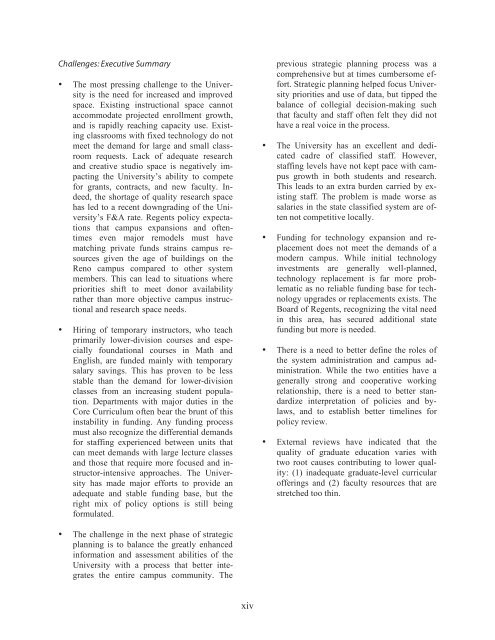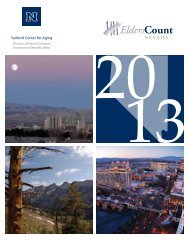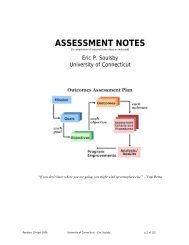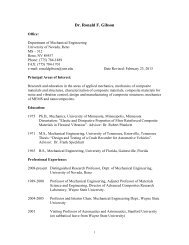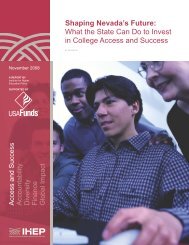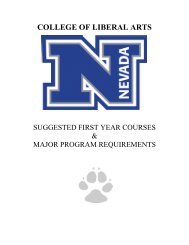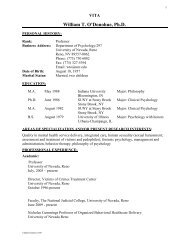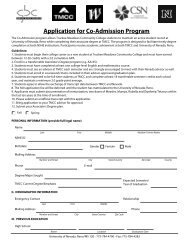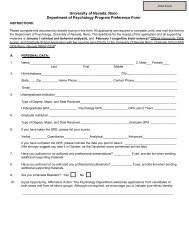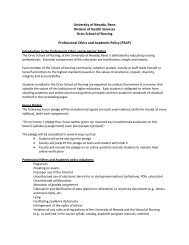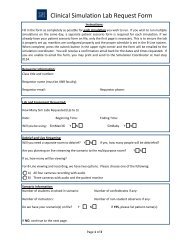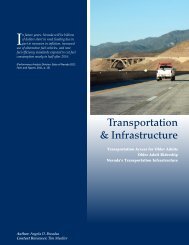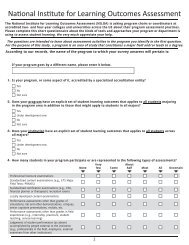2007 Self-Study - University of Nevada, Reno
2007 Self-Study - University of Nevada, Reno
2007 Self-Study - University of Nevada, Reno
Create successful ePaper yourself
Turn your PDF publications into a flip-book with our unique Google optimized e-Paper software.
Challenges: Executive Summary<br />
• The most pressing challenge to the <strong>University</strong><br />
is the need for increased and improved<br />
space. Existing instructional space cannot<br />
accommodate projected enrollment growth,<br />
and is rapidly reaching capacity use. Existing<br />
classrooms with fixed technology do not<br />
meet the demand for large and small classroom<br />
requests. Lack <strong>of</strong> adequate research<br />
and creative studio space is negatively impacting<br />
the <strong>University</strong>’s ability to compete<br />
for grants, contracts, and new faculty. Indeed,<br />
the shortage <strong>of</strong> quality research space<br />
has led to a recent downgrading <strong>of</strong> the <strong>University</strong>’s<br />
F&A rate. Regents policy expectations<br />
that campus expansions and <strong>of</strong>tentimes<br />
even major remodels must have<br />
matching private funds strains campus resources<br />
given the age <strong>of</strong> buildings on the<br />
<strong>Reno</strong> campus compared to other system<br />
members. This can lead to situations where<br />
priorities shift to meet donor availability<br />
rather than more objective campus instructional<br />
and research space needs.<br />
• Hiring <strong>of</strong> temporary instructors, who teach<br />
primarily lower-division courses and especially<br />
foundational courses in Math and<br />
English, are funded mainly with temporary<br />
salary savings. This has proven to be less<br />
stable than the demand for lower-division<br />
classes from an increasing student population.<br />
Departments with major duties in the<br />
Core Curriculum <strong>of</strong>ten bear the brunt <strong>of</strong> this<br />
instability in funding. Any funding process<br />
must also recognize the differential demands<br />
for staffing experienced between units that<br />
can meet demands with large lecture classes<br />
and those that require more focused and instructor-intensive<br />
approaches. The <strong>University</strong><br />
has made major efforts to provide an<br />
adequate and stable funding base, but the<br />
right mix <strong>of</strong> policy options is still being<br />
formulated.<br />
previous strategic planning process was a<br />
comprehensive but at times cumbersome effort.<br />
Strategic planning helped focus <strong>University</strong><br />
priorities and use <strong>of</strong> data, but tipped the<br />
balance <strong>of</strong> collegial decision-making such<br />
that faculty and staff <strong>of</strong>ten felt they did not<br />
have a real voice in the process.<br />
• The <strong>University</strong> has an excellent and dedicated<br />
cadre <strong>of</strong> classified staff. However,<br />
staffing levels have not kept pace with campus<br />
growth in both students and research.<br />
This leads to an extra burden carried by existing<br />
staff. The problem is made worse as<br />
salaries in the state classified system are <strong>of</strong>ten<br />
not competitive locally.<br />
• Funding for technology expansion and replacement<br />
does not meet the demands <strong>of</strong> a<br />
modern campus. While initial technology<br />
investments are generally well-planned,<br />
technology replacement is far more problematic<br />
as no reliable funding base for technology<br />
upgrades or replacements exists. The<br />
Board <strong>of</strong> Regents, recognizing the vital need<br />
in this area, has secured additional state<br />
funding but more is needed.<br />
• There is a need to better define the roles <strong>of</strong><br />
the system administration and campus administration.<br />
While the two entities have a<br />
generally strong and cooperative working<br />
relationship, there is a need to better standardize<br />
interpretation <strong>of</strong> policies and bylaws,<br />
and to establish better timelines for<br />
policy review.<br />
• External reviews have indicated that the<br />
quality <strong>of</strong> graduate education varies with<br />
two root causes contributing to lower quality:<br />
(1) inadequate graduate-level curricular<br />
<strong>of</strong>ferings and (2) faculty resources that are<br />
stretched too thin.<br />
• The challenge in the next phase <strong>of</strong> strategic<br />
planning is to balance the greatly enhanced<br />
information and assessment abilities <strong>of</strong> the<br />
<strong>University</strong> with a process that better integrates<br />
the entire campus community. The<br />
xiv


